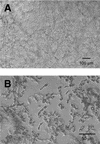In vitro antifungal activity of Micafungin (FK463) against dimorphic fungi: comparison of yeast-like and mycelial forms
- PMID: 12654673
- PMCID: PMC152532
- DOI: 10.1128/AAC.47.4.1376-1381.2003
In vitro antifungal activity of Micafungin (FK463) against dimorphic fungi: comparison of yeast-like and mycelial forms
Abstract
The characteristics of in vitro micafungin (FK463) antifungal activity against six species of dimorphic fungi were investigated in accordance with the NCCLS M27-A microdilution methods. MICs of micafungin, amphotericin B, itraconazole, and fluconazole for Histoplasma capsulatum var. capsulatum, Blastomyces dermatitidis, Paracoccidioides brasiliensis, Penicillium marneffei, and Sporothrix schenckii were determined both for the yeast-like form and mycelial form. Coccidioides immitis was tested only in its mycelial form. We have clearly demonstrated that the in vitro activity of micafungin depends considerably on the growth form of dimorphic fungi. Micafungin exhibited potent activity against the mycelial forms of H. capsulatum, B. dermatitidis, and C. immitis (MIC range, 0.0078 to 0.0625 micro g/ml), while it was very weakly active against their yeast-like forms (MIC range, 32 to >64 micro g/ml). Micafungin was also more active against the mycelial forms than the yeast-like forms of Paracoccidioides brasiliensis, Penicillium marneffei, and S. schenckii. The MICs of amphotericin B were 2 to 5 dilutions lower for the mycelial forms than for the yeast-like forms of B. dermatitidis and Paracoccidioides brasiliensis. There was no apparent difference in the activity of itraconazole between the two forms. The MICs of fluconazole for the yeast-like forms were generally lower than those for the mycelial forms, and considerably so for B. dermatitidis. These results suggest that the growth form employed in antifungal susceptibility testing of dimorphic fungi can considerably influence the interpretation of results. At present, it cannot be judged whether micafungin has clinical usefulness for dimorphic fungus infections, since for most fungi it remains uncertain which growth form correlates better with therapeutic outcome. However, the results of this study warrant further investigations of micafungin as a therapeutic agent for infections caused by dimorphic fungi.
Figures



Similar articles
-
In vitro antifungal activities of anidulafungin and micafungin, licensed agents and the investigational triazole posaconazole as determined by NCCLS methods for 12,052 fungal isolates: review of the literature.Rev Iberoam Micol. 2003 Dec;20(4):121-36. Rev Iberoam Micol. 2003. PMID: 15456349 Review.
-
In vitro activities of a new lipopeptide antifungal agent, FK463, against a variety of clinically important fungi.Antimicrob Agents Chemother. 2000 Jan;44(1):57-62. doi: 10.1128/AAC.44.1.57-62.2000. Antimicrob Agents Chemother. 2000. PMID: 10602723 Free PMC article.
-
In vitro antifungal activity of FK463, a new water-soluble echinocandin-like lipopeptide.J Antimicrob Chemother. 2000 Sep;46(3):485-7. doi: 10.1093/jac/46.3.485. J Antimicrob Chemother. 2000. PMID: 10980180
-
In vitro antifungal activity of a novel lipopeptide antifungal agent, FK463, against various fungal pathogens.J Antibiot (Tokyo). 2000 Oct;53(10):1175-81. doi: 10.7164/antibiotics.53.1175. J Antibiot (Tokyo). 2000. PMID: 11132964
-
Micafungin sodium (FK-463).Drugs Today (Barc). 2002 Apr;38(4):245-57. doi: 10.1358/dot.2002.38.4.820091. Drugs Today (Barc). 2002. PMID: 12532193 Review.
Cited by
-
In vitro activities of caspofungin, amphotericin B and azoles against Coccidioides posadasii strains from Northeast, Brazil.Mycopathologia. 2006 Jan;161(1):21-6. doi: 10.1007/s11046-005-0177-0. Mycopathologia. 2006. PMID: 16389480
-
MALDI-TOF MS-Based Clustering and Antifungal Susceptibility Tests of Talaromyces marneffei Isolates from Fujian and Guangxi (China).Infect Drug Resist. 2022 Jul 1;15:3449-3457. doi: 10.2147/IDR.S364439. eCollection 2022. Infect Drug Resist. 2022. PMID: 35800121 Free PMC article.
-
Identification of New Antifungal Compounds Targeting Thioredoxin Reductase of Paracoccidioides Genus.PLoS One. 2015 Nov 16;10(11):e0142926. doi: 10.1371/journal.pone.0142926. eCollection 2015. PLoS One. 2015. PMID: 26569405 Free PMC article.
-
In vitro effect of sulfamethoxazole-trimethoprim against Histoplasma capsulatum var. capsulatum.Antimicrob Agents Chemother. 2010 Sep;54(9):3978-9. doi: 10.1128/AAC.00793-10. Epub 2010 Jun 21. Antimicrob Agents Chemother. 2010. PMID: 20566767 Free PMC article.
-
Review of the pharmacology and clinical studies of micafungin.Drug Des Devel Ther. 2009 Dec 29;3:295-302. doi: 10.2147/dddt.s3242. Drug Des Devel Ther. 2009. PMID: 20054447 Free PMC article.
References
-
- Chandlar, F. W., M. M. McNeil, and L. Kaufman. 1998. Emerging fungal infection: histoplasmosis, phaeohyphomycosis, and sporotricosis, p. 115-144. In A. M. Nelson and C. R. Horsburgh, Jr. (ed.), Pathology of emerging infection 2. American Society for Microbiology, Washington, D.C.
-
- Drutz, D. J., and M. Huppert. 1983. Coccidioidomycosis: factors affecting the host-parasite interaction. J. Infect. Dis. 147:372-390. - PubMed
-
- Espinel-Ingroff, A. 1997. Clinical relevance of antifungal resistance. Infect. Dis. Clin. N. Am. 11:929-944. - PubMed
Publication types
MeSH terms
Substances
LinkOut - more resources
Full Text Sources
Medical
Research Materials

